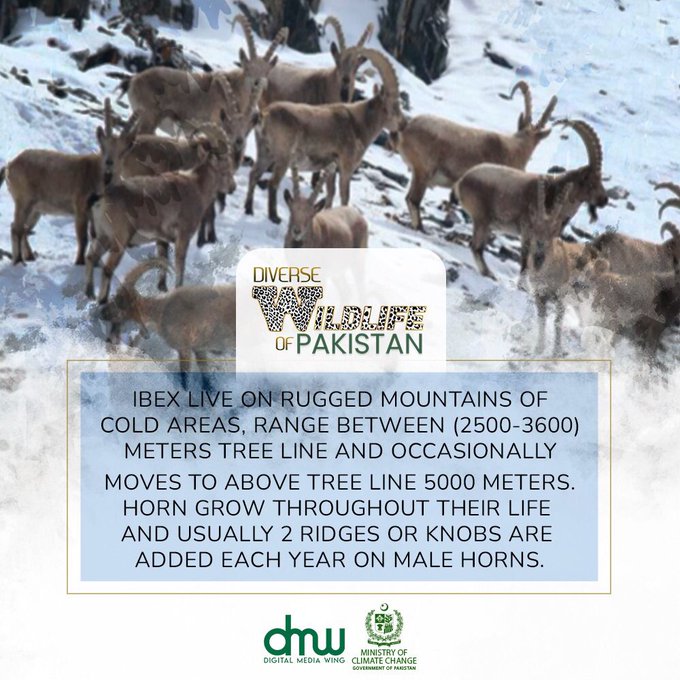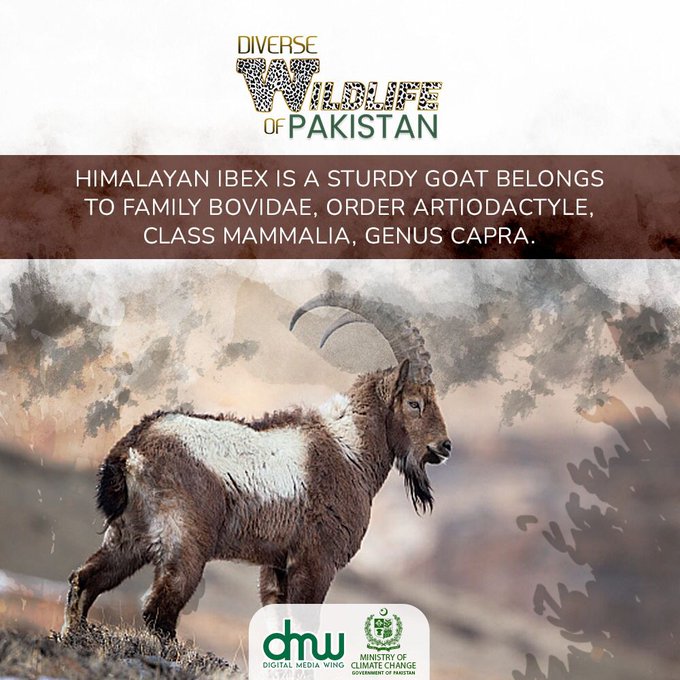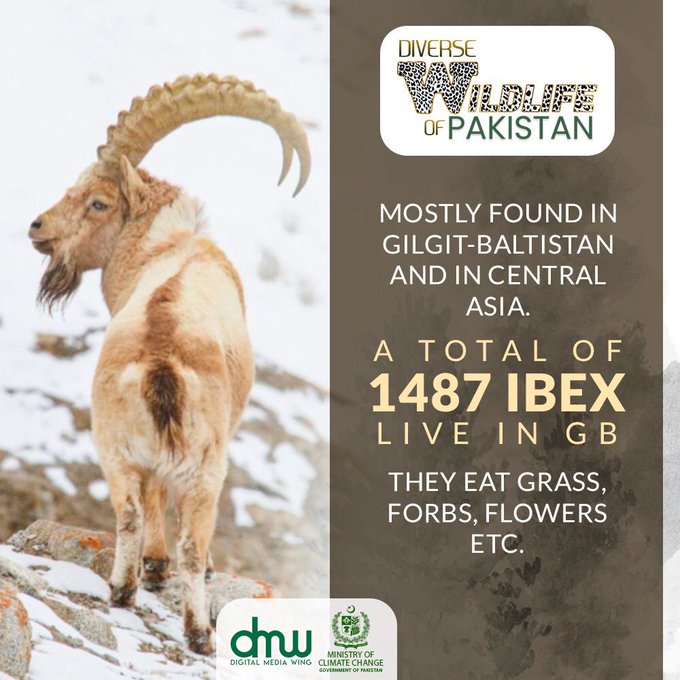How to install the app on iOS
Follow along with the video below to see how to install our site as a web app on your home screen.
Note: This feature may not be available in some browsers.
You are using an out of date browser. It may not display this or other websites correctly.
You should upgrade or use an alternative browser.
You should upgrade or use an alternative browser.
Pakistan Wild Life
- Thread starter ghazi52
- Start date
ghazi52
PDF THINK TANK: ANALYST

- Joined
- Mar 21, 2007
- Messages
- 104,413
- Reaction score
- 106
- Country
- Location
Resurgence of leopards in Islamabad's Margala Hills
Reuters
October 15, 2021
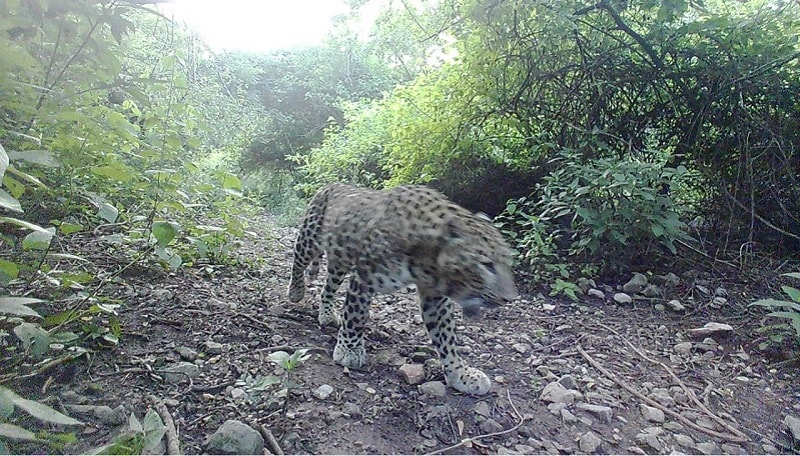
A leopard caught on camera by IWMB. — Photo courtesy: IWMB Chair Rina Khan Satti/Twitter
A leopard pauses to take a cautious look around before continuing its way through the thick forest in the Margalla Hills overlooking Islamabad — once a rare sight, but now one recorded and tracked by software and cameras.
The cat, once found all over Pakistan but increasingly endangered as humans encroach on their habitat, has been recorded painstakingly by the 20 camera traps attached to trees throughout the forested hills that are also popular with hikers.
"They are being seen on our cameras every day," said Asad Hyat, chief forest guard for the Islamabad Wildlife Management Board.
Software identifying the leopards' distinctive rosette patterns has shown seven of the big cats are in the area, which rangers say is a good sign after a significant decline in their numbers over the past few decades.
"They are not so common anymore, because they are being killed mercilessly," said IWMB Chair Rina Khan Satti.
"They were once found all over Pakistan, in almost all the provinces, and now the numbers are declining very fast because of loss of habitat, because of poaching, because of people hunting them for their skin, for their trophies."
To help the cats, Prime Minister Imran Khan on Wednesday ordered a leopard preservation zone with a roughly 10 kilometres (6.2 miles) radius be set up at Margalla Hills in an effort to protect the endangered species' natural habitat.
In recent years there have been signs of a leopard comeback in the park located just outside of Islamabad.
Conservationists say the animals likely drifted to the Margalla area — foothills of the Himalaya mountains — as it became heavily forested over the years. And they stayed on because they found prey, a stable environment and an eco-system that could support them.
Wildlife rangers check paw tracks on the forest soil daily to monitor the leopards' movements and numbers carefully. They use the footage from their cameras to record their activity.
"This is just the beginning of our scientific study, it will take time," said Satti.
News of the leopards has slowly spread and the IWMB says it is hoping to conduct tours to show the footprints and signs of the leopards in the wild to curious visitors.
Reuters
October 15, 2021

A leopard caught on camera by IWMB. — Photo courtesy: IWMB Chair Rina Khan Satti/Twitter
A leopard pauses to take a cautious look around before continuing its way through the thick forest in the Margalla Hills overlooking Islamabad — once a rare sight, but now one recorded and tracked by software and cameras.
The cat, once found all over Pakistan but increasingly endangered as humans encroach on their habitat, has been recorded painstakingly by the 20 camera traps attached to trees throughout the forested hills that are also popular with hikers.
"They are being seen on our cameras every day," said Asad Hyat, chief forest guard for the Islamabad Wildlife Management Board.
Software identifying the leopards' distinctive rosette patterns has shown seven of the big cats are in the area, which rangers say is a good sign after a significant decline in their numbers over the past few decades.
"They are not so common anymore, because they are being killed mercilessly," said IWMB Chair Rina Khan Satti.
"They were once found all over Pakistan, in almost all the provinces, and now the numbers are declining very fast because of loss of habitat, because of poaching, because of people hunting them for their skin, for their trophies."
To help the cats, Prime Minister Imran Khan on Wednesday ordered a leopard preservation zone with a roughly 10 kilometres (6.2 miles) radius be set up at Margalla Hills in an effort to protect the endangered species' natural habitat.
In recent years there have been signs of a leopard comeback in the park located just outside of Islamabad.
Conservationists say the animals likely drifted to the Margalla area — foothills of the Himalaya mountains — as it became heavily forested over the years. And they stayed on because they found prey, a stable environment and an eco-system that could support them.
Wildlife rangers check paw tracks on the forest soil daily to monitor the leopards' movements and numbers carefully. They use the footage from their cameras to record their activity.
"This is just the beginning of our scientific study, it will take time," said Satti.
News of the leopards has slowly spread and the IWMB says it is hoping to conduct tours to show the footprints and signs of the leopards in the wild to curious visitors.
ghazi52
PDF THINK TANK: ANALYST

- Joined
- Mar 21, 2007
- Messages
- 104,413
- Reaction score
- 106
- Country
- Location
Dolphin that strayed is moved to sanctuary in Pakistan
Reuters
08 Nov 2021
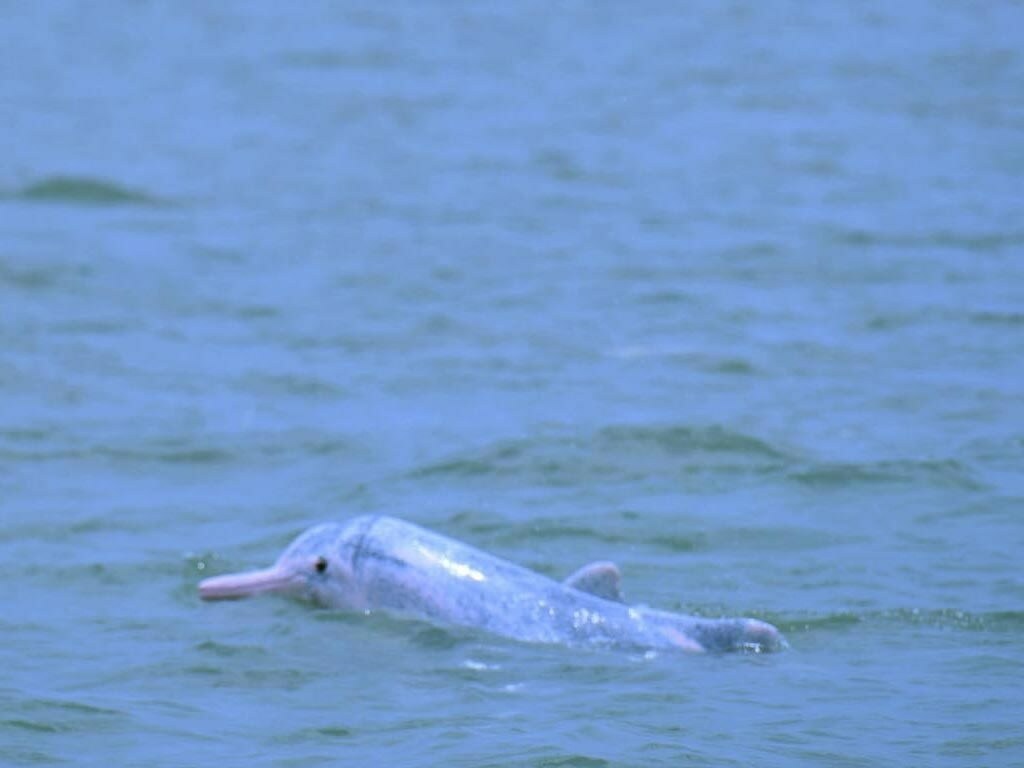
LARKANA: An endangered grey dolphin twitches its flippers weakly as it lies in a truck speeding towards a sanctuary in Pakistan, while rescuers sprinkle water on the animal to keep its skin moist and save it from dying.
Blind, with a snout equipped with two rows of sharp teeth, the Indus river dolphin strayed from its freshwater home into a busy waterway, and had to be lifted out by rescue staff in the southeastern province of Sindh after they trapped it in nets.
Now they must keep it alive as they race to the sanctuary 82 km (51 miles) away where they can free it.
"We have to try and get it to the river as soon as possible," said Mir Akhtar Hussain Talpur, an official of the provincial wildlife department, which has rescued 10 of the animals this year, eight of them in just the last month.
"When we are taking a rescued dolphin to the river, we have to be very careful," he said.
It was a delicate task to keep the skin wet and foster the animal's impression of being still in the water, while ensuring no fluid entered the blowhole by which it breathes, he added.
The dolphins are being squeezed out of their habitat after human activity, from dams for irrigation projects to pollution, penned them into a 1,200-km (750-mile) stretch of Pakistan's Indus river, or just half their original range.
Living for millions of years in the turbid waters, the mammals, just one of four surviving freshwater species, eventually went blind and use echolocation, or a form of sonar, for navigation.
They can grow to a length of more than two metres (2 yards) and exceed 100 kg (220 lb) in weight, feeding on catfish, carp and prawns, but need waters at least a metre deep to keep alive.
Some smaller animals stray into shallow irrigation canals, ponds and even fields, where they cannot survive. Although hunting them is banned, Sindh wildlife officials say that getting entangled in fishing nets remains a key threat.
But protection efforts have paid off, with numbers rebounding to 1,816 in 2019, up by half from 2001, a WWF survey showed. That was a far cry from the figure of 132 in 1972 that brought endangered status, leading to creation of the sanctuary.
About 30 animals have died in the roughly 200 rescue efforts Pakistan has launched since 1992. But all 27 rescues after 2019 have succeeded.
Reuters
08 Nov 2021

LARKANA: An endangered grey dolphin twitches its flippers weakly as it lies in a truck speeding towards a sanctuary in Pakistan, while rescuers sprinkle water on the animal to keep its skin moist and save it from dying.
Blind, with a snout equipped with two rows of sharp teeth, the Indus river dolphin strayed from its freshwater home into a busy waterway, and had to be lifted out by rescue staff in the southeastern province of Sindh after they trapped it in nets.
Now they must keep it alive as they race to the sanctuary 82 km (51 miles) away where they can free it.
"We have to try and get it to the river as soon as possible," said Mir Akhtar Hussain Talpur, an official of the provincial wildlife department, which has rescued 10 of the animals this year, eight of them in just the last month.
"When we are taking a rescued dolphin to the river, we have to be very careful," he said.
It was a delicate task to keep the skin wet and foster the animal's impression of being still in the water, while ensuring no fluid entered the blowhole by which it breathes, he added.
The dolphins are being squeezed out of their habitat after human activity, from dams for irrigation projects to pollution, penned them into a 1,200-km (750-mile) stretch of Pakistan's Indus river, or just half their original range.
Living for millions of years in the turbid waters, the mammals, just one of four surviving freshwater species, eventually went blind and use echolocation, or a form of sonar, for navigation.
They can grow to a length of more than two metres (2 yards) and exceed 100 kg (220 lb) in weight, feeding on catfish, carp and prawns, but need waters at least a metre deep to keep alive.
Some smaller animals stray into shallow irrigation canals, ponds and even fields, where they cannot survive. Although hunting them is banned, Sindh wildlife officials say that getting entangled in fishing nets remains a key threat.
But protection efforts have paid off, with numbers rebounding to 1,816 in 2019, up by half from 2001, a WWF survey showed. That was a far cry from the figure of 132 in 1972 that brought endangered status, leading to creation of the sanctuary.
About 30 animals have died in the roughly 200 rescue efforts Pakistan has launched since 1992. But all 27 rescues after 2019 have succeeded.
ghazi52
PDF THINK TANK: ANALYST

- Joined
- Mar 21, 2007
- Messages
- 104,413
- Reaction score
- 106
- Country
- Location
Our Guest Birds are here to enjoy not to die.
Pease Ban on hunting.
In every winter thousands of migratory birds like these beautiful flamingos come from as far as Siberia to this lake near village Sankar in Tharparkar Desert of Sindh ..
ghazi52
PDF THINK TANK: ANALYST

- Joined
- Mar 21, 2007
- Messages
- 104,413
- Reaction score
- 106
- Country
- Location
LHC forms committee to examine wildlife possession laws
CJP's daughter challenges act which allows keeping wildlife animals as pets
Rana Yasif
November 10, 2021
LAHORE: Justice Jawad Hassan of the Lahore High Court (LHC) formed a committee on Wednesday to examine the loopholes in laws that allow keeping wild animals as pets.
Justice Jawad was hearing a petition – filed by the daughter of the Chief Justice of Pakistan Gulzar Ahmed – that challenged Section 12 of the Punjab Wildlife Act 1974, through which wild animals were deprived of their natural habitats and kept in confinement.
The wildlife secretary will lead the committee, Justice Jawad stated, adding that the court would alter the act if need be.
During the proceedings, a wildlife officer told the court that no one issued the license to keep wild animals at home and that licenses were issued only for those animals which could easily be looked after at homes.
The petitioners, Sanita Gulzar and Syed Muhammad Ghazenfur filed the petition making the provincial government, wildlife department secretary, World Wildlife Fund-Pakistan (WWF) president and Ministry of Climate Change as respondents.
She maintained that due to Section 12 wild animals have been unnecessarily deprived and kept in confined spaces for the mere entertainment of humans, with little to no supervision from the concerned authorities.
Sanita further highlighted that the wild animals were often tortured, mistreated, starved, mishandled, drugged, agitated and exposed to bad living conditions, which is detrimental for their mental and physical well-being. Resultantly, the fundamental right to liberty – enshrined under Article 9 of the Constitution – of these wild animals is unjustifiably infringed.
She added that the right to life and liberty as written in Article 9 has been interpreted to extend beyond human beings and apply to animals in general as well.
Sanita stated that the respondent province of Punjab has more than 200 breeding farms across the province and more than 20 specialise in breeding exotic tigers and other big cats. Over the past five years, Pakistan has imported more than 85 big cats including pumas, tigers, lions and leopards to name a few. Out of the total, 15 ended up as trophies for hunters.
According to the respondent WWF, a leading organisation in wildlife conservation, the factors stated above played a significant role in shrinking the population of tigers globally.
Quoting some examples of the video clips which went viral, Sanita said that two lions met a terrible fate at the hands of unprofessional animal caretakers as they died while being transferred to a private lion farm.
She implored the court to declare that Section 12 of the Act is ultra vires the Constitution, and that it infringes upon the rights enshrined under Article 9 and Article 14 of the Constitution.
She further asked the court to suspend the operation of Sections 12 (b) prohibit respondent (no-2) from issuing licenses under the Act.
Section 12(1) states that "Certificate of lawful possession: 12 (1) No person shall be in possession of any wild animal unless he be in possession of a certificate of lawful possession granted in respect thereof by the officer authorized in this behalf.
"Provided that any person importing any wild animal, trophy or meat of a wild animal of a kind specified in the Second Schedule in accordance with the provisions of this Act or acquiring such animal, trophy or meat in accordance with the terms of a permit issued under this Act shall apply to the authorized officer for such certificate within thirty days from the date of importing or acquiring the animal, trophy or meat.”
CJP's daughter challenges act which allows keeping wildlife animals as pets
Rana Yasif
November 10, 2021
LAHORE: Justice Jawad Hassan of the Lahore High Court (LHC) formed a committee on Wednesday to examine the loopholes in laws that allow keeping wild animals as pets.
Justice Jawad was hearing a petition – filed by the daughter of the Chief Justice of Pakistan Gulzar Ahmed – that challenged Section 12 of the Punjab Wildlife Act 1974, through which wild animals were deprived of their natural habitats and kept in confinement.
The wildlife secretary will lead the committee, Justice Jawad stated, adding that the court would alter the act if need be.
During the proceedings, a wildlife officer told the court that no one issued the license to keep wild animals at home and that licenses were issued only for those animals which could easily be looked after at homes.
The petitioners, Sanita Gulzar and Syed Muhammad Ghazenfur filed the petition making the provincial government, wildlife department secretary, World Wildlife Fund-Pakistan (WWF) president and Ministry of Climate Change as respondents.
She maintained that due to Section 12 wild animals have been unnecessarily deprived and kept in confined spaces for the mere entertainment of humans, with little to no supervision from the concerned authorities.
Sanita further highlighted that the wild animals were often tortured, mistreated, starved, mishandled, drugged, agitated and exposed to bad living conditions, which is detrimental for their mental and physical well-being. Resultantly, the fundamental right to liberty – enshrined under Article 9 of the Constitution – of these wild animals is unjustifiably infringed.
She added that the right to life and liberty as written in Article 9 has been interpreted to extend beyond human beings and apply to animals in general as well.
Sanita stated that the respondent province of Punjab has more than 200 breeding farms across the province and more than 20 specialise in breeding exotic tigers and other big cats. Over the past five years, Pakistan has imported more than 85 big cats including pumas, tigers, lions and leopards to name a few. Out of the total, 15 ended up as trophies for hunters.
According to the respondent WWF, a leading organisation in wildlife conservation, the factors stated above played a significant role in shrinking the population of tigers globally.
Quoting some examples of the video clips which went viral, Sanita said that two lions met a terrible fate at the hands of unprofessional animal caretakers as they died while being transferred to a private lion farm.
She implored the court to declare that Section 12 of the Act is ultra vires the Constitution, and that it infringes upon the rights enshrined under Article 9 and Article 14 of the Constitution.
She further asked the court to suspend the operation of Sections 12 (b) prohibit respondent (no-2) from issuing licenses under the Act.
Section 12(1) states that "Certificate of lawful possession: 12 (1) No person shall be in possession of any wild animal unless he be in possession of a certificate of lawful possession granted in respect thereof by the officer authorized in this behalf.
"Provided that any person importing any wild animal, trophy or meat of a wild animal of a kind specified in the Second Schedule in accordance with the provisions of this Act or acquiring such animal, trophy or meat in accordance with the terms of a permit issued under this Act shall apply to the authorized officer for such certificate within thirty days from the date of importing or acquiring the animal, trophy or meat.”
ghazi52
PDF THINK TANK: ANALYST

- Joined
- Mar 21, 2007
- Messages
- 104,413
- Reaction score
- 106
- Country
- Location
ghazi52
PDF THINK TANK: ANALYST

- Joined
- Mar 21, 2007
- Messages
- 104,413
- Reaction score
- 106
- Country
- Location
ghazi52
PDF THINK TANK: ANALYST

- Joined
- Mar 21, 2007
- Messages
- 104,413
- Reaction score
- 106
- Country
- Location
Similar threads
- Replies
- 0
- Views
- 2K
- Replies
- 0
- Views
- 196


